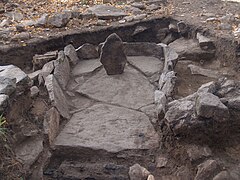Megaliths on the island of Vera
The Neolithic megaliths on the island of Vera (Russian Віри - Island of Faith) are located in the west of the 2638 hectare Turgoyak Lake (Russian Тургояк) in the Urals , near Miass, west of Chelyabinsk in the Chelyabinsk Oblast in Russia . When the water level is low, the island is connected to the land by a dam.
The largest megalithic complex on the island is an approximately 19.0 × 6.0 m west-east oriented structure made of dry masonry , cut into the bedrock and covered with megalithic capstones. The interior consists of a long corridor, the central hall and two chambers (west and north) which are connected by a corridor. The height of the chambers is at least 1.9 m, often more than 2.0 m. The partially destroyed access is in the east. The size of the complex with hatches and sculptures of animal heads (bull and wolf) distinguishes it from the other megalithic complexes on the island.
The second largest megalithic complex on the island is a north-south oriented stone structure that was integrated into a rocky slope. Their internal size is approximately 7.5 × 3.5 m. It consists of two 1.7 m high chambers that are connected by a corridor. The southern chamber and the corridor are made of slabs, the northern one of solid boulders. Inside there is a system of niches and shelves, which were probably filled with ritual objects during use. The floor was covered with a layer of clay screed. A niche lies above the entrance to the south chamber, which faces west.
Another megalithic structure consists of several large boulders (the weight of the largest is 14-15 tons). Between the blocks there is an opening 25–30 cm wide in a square rock pit. Vertical stone slabs closed both sides of the construction. Solid boulders had been prepared as capstones. To the east, the complex has a gravel hill that has not yet been excavated.
- Megaliths of the island of Vera
The fourth place of worship is north-south oriented. It is bordered on three sides with vertically laid granite slabs , in the middle of the area there was a small worked menhir in antiquity. The stone box-like , rectangular structure measures around 5.5 × 4.0 m.
A place on the island called a cult place (Vera 9) consists of two menhirs whose axes are oriented west-east. This orientation is typical of the island. There were also two stoves and a large altar stone.
There is a larger menhir in the southeast. This menhir was erected to mark a direction for sunset in the middle of winter. The purpose of the open-air sanctuary was seasonal rituals.
There are about 40 archaeological sites on the island, a quarry from the 4th millennium BC. And the ruins of a monastery from the 19th century. Research has been ongoing on the island since 2004. A museum complex to research and preserve the megaliths is planned.
literature
- Stanislav A. Grigoriev, Julia V. Vasina: Megaliths of the Vera Island in the Southern Urals. In: British archaeological report. International series 2123. Monumental questions: prehistoric megaliths, mounds and enclosures. Oxford, 2010, pp. 179-185. (Online, PDF)
Web links
Coordinates: 55 ° 9 ′ 41 ″ N , 60 ° 1 ′ 55 ″ E






